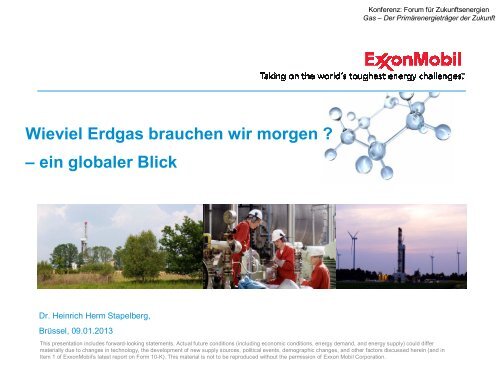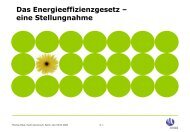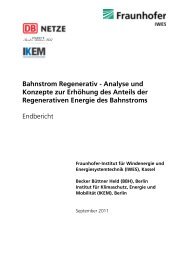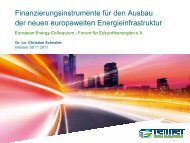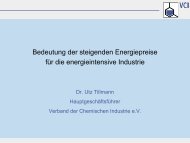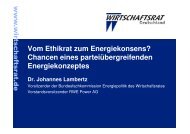Wieviel Erdgas brauchen wir morgen ? – ein globaler Blick
Wieviel Erdgas brauchen wir morgen ? – ein globaler Blick
Wieviel Erdgas brauchen wir morgen ? – ein globaler Blick
You also want an ePaper? Increase the reach of your titles
YUMPU automatically turns print PDFs into web optimized ePapers that Google loves.
<strong>Wieviel</strong> <strong>Erdgas</strong> <strong>brauchen</strong> <strong>wir</strong> <strong>morgen</strong> ?<br />
<strong>–</strong> <strong>ein</strong> <strong>globaler</strong> <strong>Blick</strong><br />
Dr. H<strong>ein</strong>rich Herm Stapelberg,<br />
Brüssel, 09.01.2013<br />
Konferenz: Forum für Zukunftsenergien<br />
Gas <strong>–</strong> Der Primärenergieträger der Zukunft<br />
This presentation includes forward-looking statements. Actual future conditions (including economic conditions, energy demand, and energy supply) could differ<br />
materially due to changes in technology, the development of new supply sources, political events, demographic changes, and other factors discussed her<strong>ein</strong> (and in<br />
Item 1 of ExxonMobil’s latest report on Form 10-K). This material is not to be reproduced without the permission of Exxon Mobil Corporation.
100<br />
80<br />
60<br />
40<br />
20<br />
0<br />
Energy Use Evolves Over Time<br />
Global Percent Mix of Fuels<br />
Percent<br />
1800 1850 1900 1950<br />
2000 2040<br />
Source: Smil, Energy Transitions (1800-1960)<br />
Other Renewables<br />
Nuclear<br />
Hydro<br />
Gas<br />
Oil<br />
Coal<br />
Biomass
Economic Growth Drives Energy Demand<br />
GDP<br />
Trillion 2005$<br />
125<br />
100<br />
75<br />
50<br />
25<br />
2010-2040 AAGR %<br />
World<br />
2.8%<br />
Other<br />
Non<br />
OECD<br />
China<br />
Other<br />
OECD<br />
United States<br />
0<br />
2000 2020 2040<br />
ExxonMobil 2013 Outlook for Energy<br />
3.9%<br />
5.6%<br />
1.8%<br />
2.3%<br />
Energy Demand<br />
Quadrillion BTUs<br />
1250<br />
1000<br />
750<br />
500<br />
250<br />
2010-2040 AAGR %<br />
World<br />
1.0%<br />
Energy<br />
Saved<br />
~500<br />
0<br />
2000 2020 2040
Globale Energienachfrage<br />
Washington D.C.<br />
Brüssel
225<br />
200<br />
175<br />
150<br />
125<br />
100<br />
75<br />
50<br />
25<br />
0<br />
Energy Mix Continues to Evolve<br />
Quadrillion BTUs<br />
0.8%<br />
2040<br />
2010<br />
ExxonMobil 2013 Outlook for Energy<br />
1.7%<br />
-0.1%<br />
2.4%<br />
0.4%<br />
Average Growth / Yr.<br />
2010 - 2040<br />
1.0%<br />
Oil Gas Coal Nuclear Biomass Solar / Wind /<br />
Biofuels<br />
5.8% 1.8%<br />
Hydro / Geo
Electricity Generation Leads Growth<br />
Energy Demand by Sector<br />
Quadrillion BTUs<br />
300<br />
250<br />
200<br />
150<br />
100<br />
50<br />
0<br />
ExxonMobil 2013 Outlook for Energy<br />
2010<br />
2025<br />
2040<br />
Electricity<br />
Generation<br />
Industrial Transportation Res/Comm
16<br />
12<br />
8<br />
4<br />
0<br />
Economic Choices for U.S. Electricity<br />
Baseload, Startup 2030<br />
2012 cents/kWh<br />
$60/ton of CO 2<br />
$0/ton<br />
Coal Gas Nuclear Onshore<br />
Wind*<br />
*Wind and solar exclude costs for integration, backup capacity and additional transmission<br />
ExxonMobil 2013 Outlook for Energy<br />
Utility<br />
Solar PV*
Electricity Generation<br />
Quadrillion BTUs<br />
300<br />
250<br />
200<br />
150<br />
100<br />
50<br />
Fueling Electricity Generation Varies by Region<br />
Oil<br />
Renewables<br />
Nuclear<br />
Non OECD<br />
Coal<br />
OECD<br />
Gas<br />
0<br />
2000 2020 2040<br />
ExxonMobil 2013 Outlook for Energy<br />
Growth in Fuels from 2010 to 2040<br />
Quadrillion BTUs<br />
120<br />
90<br />
60<br />
30<br />
0<br />
-30<br />
Renewables<br />
Nuclear<br />
Gas<br />
Coal<br />
Oil<br />
Non OECD OECD
Natural Gas Supply and Demand Shifts<br />
ExxonMobil 2013 Outlook for Energy<br />
Global Gas Supply<br />
BCFD<br />
600<br />
500<br />
400<br />
300<br />
200<br />
100<br />
Local<br />
Conventional<br />
North America Conventional<br />
Rest of World<br />
Unconventional<br />
North America<br />
Unconventional<br />
Rest of World<br />
Conventional<br />
0<br />
2010 2025 2040
80<br />
60<br />
40<br />
20<br />
EU 27 Energy Demand and Supply<br />
By Sector<br />
Quadrillion BTUs<br />
Res/Comm<br />
Industrial<br />
Electricity<br />
Generation<br />
Transportation<br />
0<br />
2000 2010 2020 2030 2040<br />
By Fuel<br />
Quadrillion BTUs<br />
80<br />
60<br />
40<br />
20<br />
Other Renewables<br />
Biomass<br />
Nuclear<br />
Coal<br />
Gas<br />
Oil<br />
0<br />
2000 2010 2020 2030 2040
80<br />
60<br />
40<br />
20<br />
EU 27 Natural Gas Demand<br />
Total Demand<br />
Quadrillion BTUs<br />
Other<br />
Coal<br />
Gas<br />
Oil<br />
0<br />
2000 2010 2020 2030 2040<br />
Gas By Sector<br />
BCFD<br />
60<br />
45<br />
30<br />
15<br />
Res/Comm<br />
Industrial<br />
Electricity<br />
Generation<br />
Transportation<br />
0<br />
2000 2010 2020 2030 2040
Gas Supply Change 2010 - 2040<br />
By Type<br />
BCFD<br />
45<br />
30<br />
15<br />
0<br />
-15<br />
-30<br />
North America Europe<br />
LNG<br />
Pipeline<br />
Local Unconventional<br />
Local Conventional
<strong>Erdgas</strong>preise USA / Europa / Asien<br />
Henry Hub =<br />
Virtueller Handelsplatz USA<br />
(Pipelineknotenpunkt in Erath,<br />
Louisiana )<br />
NBP = National Balancing Point<br />
Virtueller Handelsplatz UK<br />
JLNG =<br />
Japan Liquefied Natural Gas<br />
Import Price
US electricity generation growth 2006-2011<br />
Over the past 5 years, natural gas & renewables were the leading sources<br />
of incremental electricity generation in the United States<br />
* Graph from IEA Presentation: A Future for Gas by Fatih Birol
Global CO 2 emissions growth 2006-2011*<br />
CO 2 emissions in the United States have now fallen by 430 Mt (7.7%)<br />
since 2006, the largest reduction of all countries or regions<br />
* Graph from IEA Presentation: A Future for Gas by Fatih Birol


